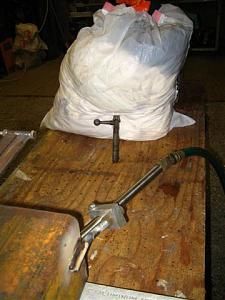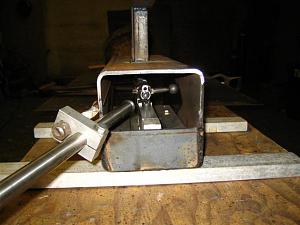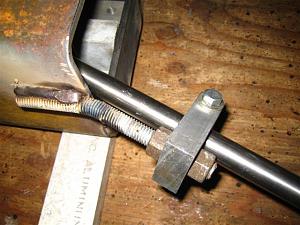I made the pneumatic device to drive the firing pin and tested it out. I've located some clay but went ahead with a prelim test. Rube Goldberg aside, it does work but not as well as I envisioned. a) the ball bearing, being harder than the cocking piece, is peening it. b) without any thing to hold the bolt in it absorbs impact and bounces back, interfering with ignition; this happens too many times. c) the ball bearing has a mind of its own and is hard to find after each launch.
I thoroughly cleaned the chamber and bore with acetone. The air delivery tube is a 50' garden hose. My lungs couldn't do it so I used compressed air (110psi) and a blow gun. I used the low-watt 170 gr REM ammo. The backstop was a garbage bag full of rags set 28" behind the action. The picture of the bolt against the bag is representative and more dramatic if anything because it looks like it stuck. It didn't really, it just hit a fold. after this first shot I elevated the torture chamber to hit the bag more squarely. With all the shots the bolt just bounced off the bag. None of them pierced the plastic. They did not knock the bag over or move it. The bag weighs 12 lbs.
With every shot these same things happened: Bolt flew out, primers disappeared, cases flew but not always in the same direction. One time, somehow, a case came out the front. All of them are marked like they struck something but not seriously damaged.
Lead balls would work much better. One thing for sure, this method is an extremely safe way to go about this business.




This is interesting and all but it would be good, I think, to come up with a way to measure what kind of energy we are talking about here. Any suggestions would be appreciated. I do not know if this would represent a 'death blow' that would 'explode ones' head' if you were so unfortunate experience it. I doubt it but I wouldn't wager. A bag of rags is not a human head. With the clay there will be some indentation. If nothing else, it will be revealing to compare the depth of indentation between dry chamber and wet chamber.
This has been a side track from the original intent but I find it very interesting. I've read of Ackley's tests with his improved chambers and how 'sticky' they are. I think that this test shows that a normal chamber is pretty sticky too, if dry, anyway.















 Reply With Quote
Reply With Quote













